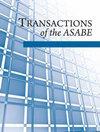奶牛废水灌溉和施肥对土壤结构和持水性的影响
IF 1.4
4区 农林科学
Q3 AGRICULTURAL ENGINEERING
引用次数: 3
摘要
对奶牛废弃物土壤持水能力进行了定量评价。考虑农场土壤的可变性对管理实践具有重要意义。土壤团聚体结构是研究废弃物回用影响的关键。畜牧业约占全球农业产出的40%,并使用了30%以上的饲料作物用地。该部门的持续增长导致了技术的提高和更大规模的商业化农业,它与副产品和废物的增长有关,这可能损害环境和人类健康。虽然有机肥是一种极好的土壤肥料,其营养成分可提高作物产量,但未经处理和/或过量施用的有机肥会污染当地水资源,并可能改变土壤团聚体结构,潜在地影响土壤健康和有效水分。适当的牲畜废物管理对可持续粮食生产至关重要。存在废物再利用战略,其目标包括尽量减少淡水消耗、改善粮食生产和促进能源生产。然而,每种战略在环境、能源或货币成本方面都有权衡。本研究提供了一种定量方法来评估废物对土壤健康的影响,并通过更好地了解管理做法如何影响土壤物理健康,帮助更好地管理干旱和半干旱地区的灌溉做法和供水缺口。利用TypoSoil仪器对细砂壤土(A层)和砂质粘土(B层)的水结构参数(持水能力和土壤结构)进行了测量和分析。从德克萨斯州A&M农业生物研究奶牛场(Stephenville, Texas)收集土壤并与对照(未接触)土壤进行比较。废物(粪便、垫料、洗涤水)被分离成液体(通过天然泻湖处理过程)和固体成分(作为肥料施用)。大约一半的废水被用作洗涤用水,其余的用于灌溉。虽然不同取样地点的土壤差异很大,但在a和B层,对照和粪肥/废水施用之间存在统计学上的显著差异。两种施用均提高了A层植物有效水分(分别为40%和30%),但降低了B层植物有效水分(分别为25%和30%)。因此,奶牛场废物是农业利用的可行来源。关键词:有效水量;土壤结构;土壤健康;本文章由计算机程序翻译,如有差异,请以英文原文为准。
Impact of Dairy Wastewater Irrigation and Manure Application on Soil Structural and Water-Holding Properties
HighlightsQuantitative evaluation was performed of dairy waste on soil water-holding capacity.Considering the soil variability on a farm is significant for management practices.Soil aggregate structure plays a pivotal role in studying the impact of waste reuse.Abstract. The livestock sector contributes about 40% of global agricultural output and uses over 30% of total feed-crop land. The sector’s continuing growth has led to increased technology and larger-scale, commercialized agriculture, and it correlates to growth in by-products and waste, which can compromise the environment and human health. Although organic manure is an excellent soil fertilizer whose nutrient content increases crop yield, untreated and/or overapplied manure pollutes local water resources and can alter soil aggregate structure, potentially affecting soil health and available water. Proper livestock waste management is essential for sustainable food production. Waste reuse strategies exist, with goals such as minimizing freshwater consumption, improving food production, and contributing to energy production, However, each strategy has tradeoffs in environmental, energy, or monetary costs. This study provides a quantitative approach to evaluating waste impact on soil health and helps to better manage irrigation practices and water supply gaps in arid and semi-arid areas by better understanding how management practices affect physical soil health. The TypoSoil apparatus was used to measure and analyze the hydrostructural parameters (water-holding capacity and soil structure) of fine sandy loam (A horizon) and sandy clay (B horizon). Soils from the Texas A&M AgriLife Research Dairy (Stephenville, Texas) were collected and compared with control (untouched) soils. Waste (manure, bedding materials, wash water) was separated into liquid (passed through a natural lagoon treatment process) and solid components (applied as fertilizer). Approximately half the wastewater was reused as wash water, the remainder for irrigation. Although the soil varied substantially between sample locations, a statistically significant difference existed between the control and manure/wastewater applications in both the A and B horizons. Both applications improved plant-available water (AW) in the A horizon (40% and 30%, respectively) but deteriorated AW in the B horizon (25% and 30%). Thus, dairy farm waste is a viable source for agricultural use. Keywords: Available water capacity, Pedostructure, Soil health, Soil shrinkage curve, Soil water characteristic curve.
求助全文
通过发布文献求助,成功后即可免费获取论文全文。
去求助
来源期刊

Transactions of the ASABE
AGRICULTURAL ENGINEERING-
CiteScore
2.30
自引率
0.00%
发文量
0
审稿时长
6 months
期刊介绍:
This peer-reviewed journal publishes research that advances the engineering of agricultural, food, and biological systems. Submissions must include original data, analysis or design, or synthesis of existing information; research information for the improvement of education, design, construction, or manufacturing practice; or significant and convincing evidence that confirms and strengthens the findings of others or that revises ideas or challenges accepted theory.
 求助内容:
求助内容: 应助结果提醒方式:
应助结果提醒方式:


